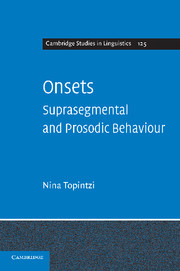Book contents
- Frontmatter
- Contents
- Preface
- Acknowledgements
- 1 Onsets and weight: the theory
- 2 Onsets and stress
- 3 Onsets and compensatory lengthening
- 4 Onsets and word minimality
- 5 Onsets and geminates
- 6 Other real and not so real onset-sensitive data: brief case-studies
- 7 Conclusion and discussion of alternatives
- References
- Subject index
- Language index
4 - Onsets and word minimality
Published online by Cambridge University Press: 06 July 2010
- Frontmatter
- Contents
- Preface
- Acknowledgements
- 1 Onsets and weight: the theory
- 2 Onsets and stress
- 3 Onsets and compensatory lengthening
- 4 Onsets and word minimality
- 5 Onsets and geminates
- 6 Other real and not so real onset-sensitive data: brief case-studies
- 7 Conclusion and discussion of alternatives
- References
- Subject index
- Language index
Summary
Introduction
This chapter deals with word minimality, that is, the requirement that certain languages have for words to exhibit a minimum size. Highly common minimum size requirements are that words are at least bimoraic (C)VV as in Ket or Mocha (Gordon 2006) or (C)VV/(C)VC, e.g. English or Evenki (Gordon 2006), or bisyllabic, e.g. Pitta-Pitta (Hayes 1995: 201). Standard moraic theory (Hyman 1985; Hayes 1989) predicts that no language with a bimoraic word-minimum will exist that allows [CV] words alongside clearly bimoraic [VV] (and [VC]) words, but bans [V] ones. This is indeed impossible given a model that onsets never contribute weight, but entirely predicted by a model such as the present one. Indeed, the minimality data of Bella Coola (also known as Nuxálk) lend support to this approach.
This chapter argues that Bella Coola onsets are moraic, although in a very marginal environment, namely in [CV] words only. This happens so that the overarching requirement of bimoraic word minimality can be satisfied. In this way, Bella Coola presents a case of coerced onset weight, where onset moraicity is enforced by a higher imperative in the language, namely word minimality (§1.3.3.5). That onsets are not generally moraic in the language is certified by the root maximality data, which impose a four-mora maximum for roots. Attested roots conform to this restriction with the provision that onsets do not contribute any moras, offering evidence that they bear no weight.
- Type
- Chapter
- Information
- OnsetsSuprasegmental and Prosodic Behaviour, pp. 137 - 163Publisher: Cambridge University PressPrint publication year: 2010



